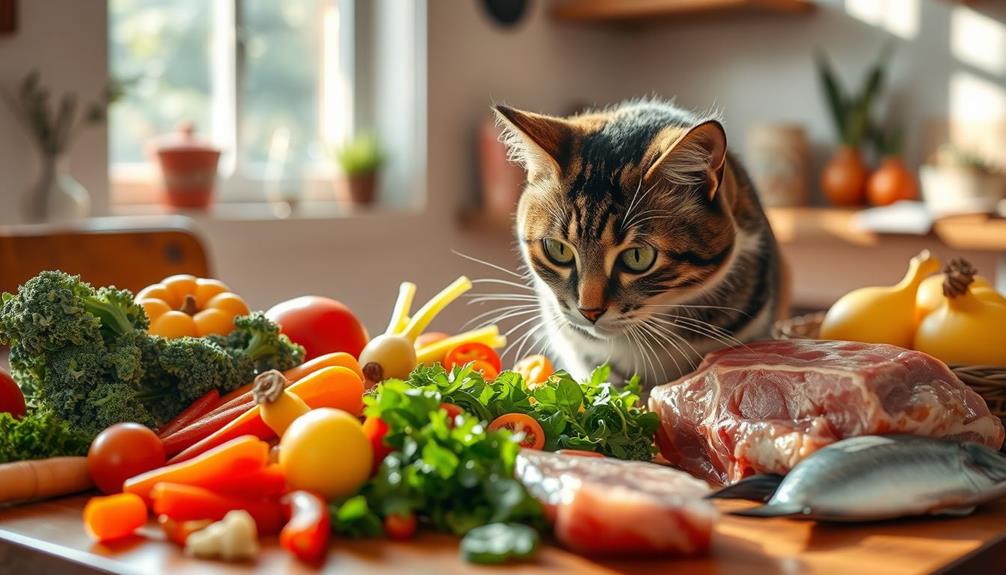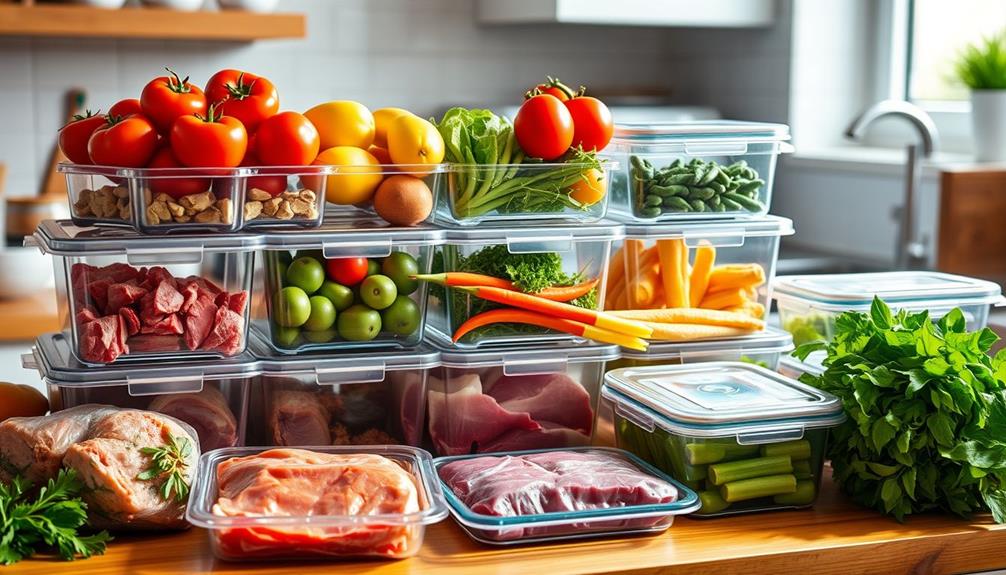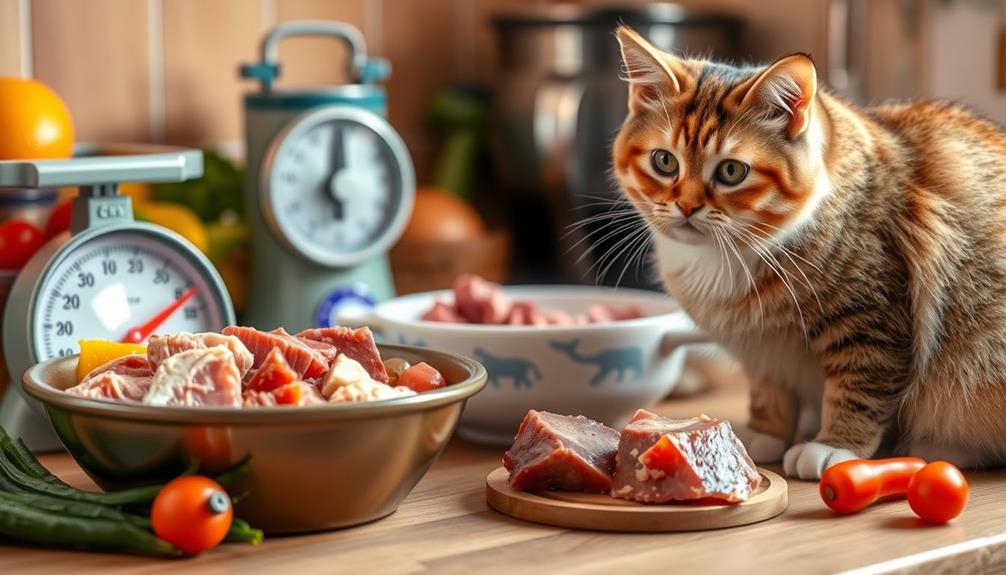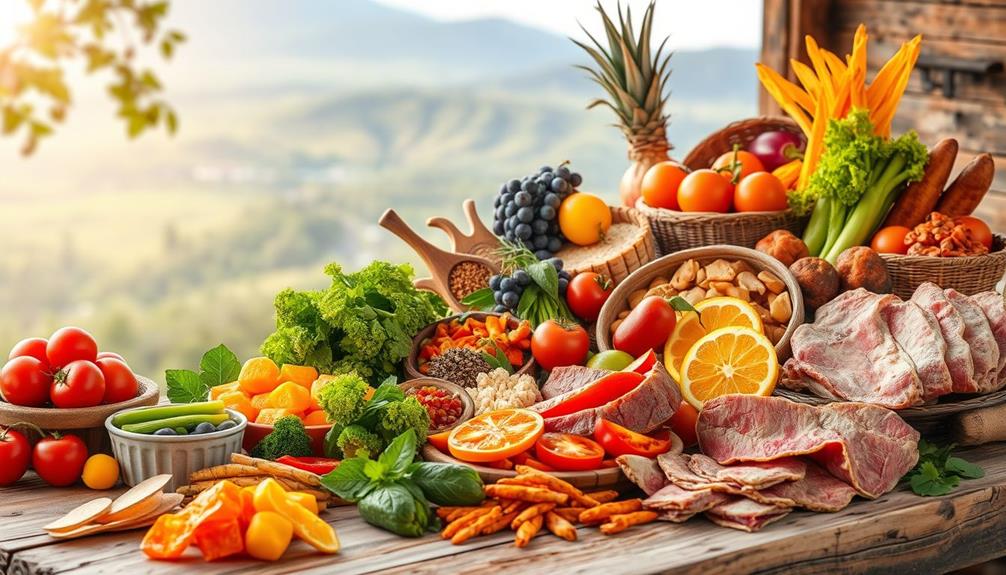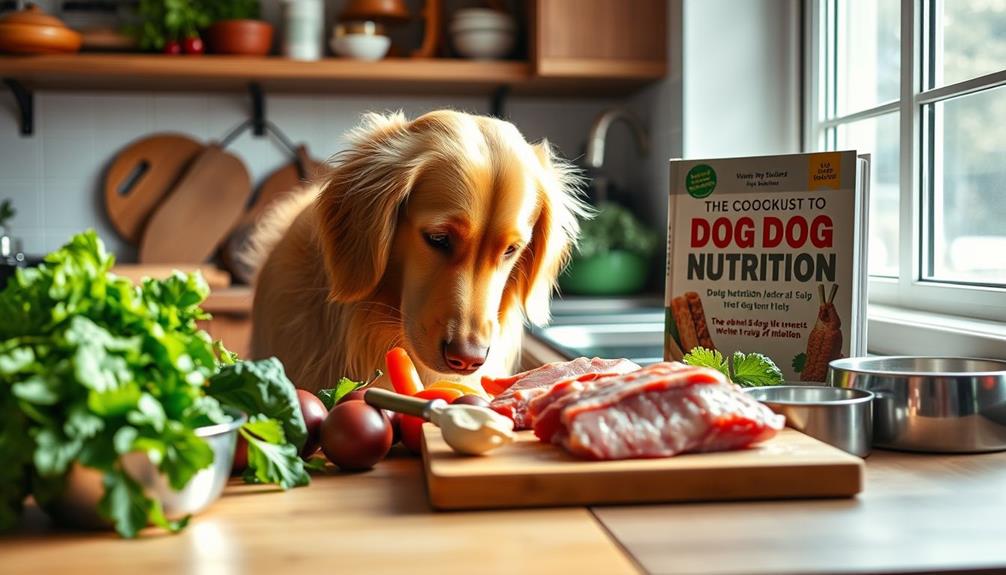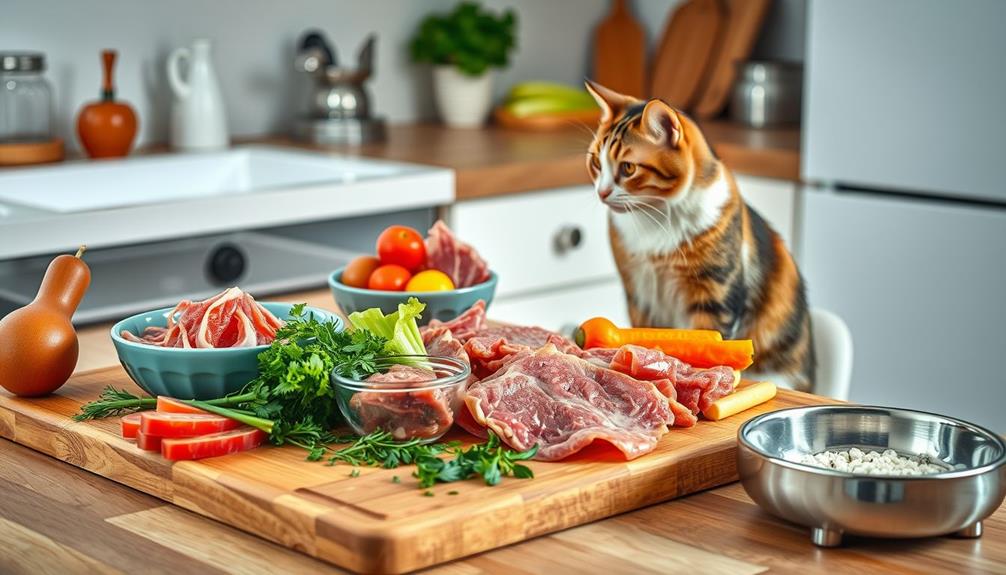A raw food diet for cats can have benefits, like improved digestion and healthier skin, but it also comes with significant risks. Many homemade raw diets lack essential nutrients, potentially leading to serious health issues. Experts recommend consulting a veterinary nutritionist for balanced and safe formulations. Commercial raw diets often meet stringent AAFCO standards for safety and nutrition, minimizing risks associated with improper handling and bacterial contamination. To make the best choice for your cat's well-being, it's vital to understand both the advantages and drawbacks of this dietary approach. You might find valuable insights on how to manage these concerns effectively. When considering a raw food diet for kittens, it’s important to be especially cautious, as their nutritional needs are different from adult cats. Kittens require higher levels of certain nutrients for proper growth and development, and an unbalanced raw diet could lead to stunted growth or other health issues. Consulting a veterinary nutritionist and carefully researching commercial raw diets formulated specifically for kittens can help ensure that they receive the essential nutrients they need for a healthy start in life.
Key Takeaways
- Raw food diets can improve digestion and skin health but require careful nutritional balance to avoid deficiencies.
- Many homemade raw diets lack essential nutrients, posing health risks to cats; consulting a veterinary nutritionist is crucial.
- Commercial raw diets often meet AAFCO standards, making them a safer option compared to homemade versions.
- Raw diets carry risks of bacterial contamination and zoonotic infections, necessitating proper handling and hygiene practices.
- Experts advise regular veterinary check-ups to monitor health impacts and nutritional adequacy for cats on raw diets.
What Is a Raw Food Diet?
A raw food diet (RFD) for cats involves feeding them uncooked animal products like muscle meat, organ meat, and ground bones, closely mimicking what their wild counterparts eat. This diet typically includes common ingredients such as chicken, fish, and eggs, but you can also incorporate a variety of other meats based on specific formulations.
Proper nutrition is vital for overall health, and making sure your cat receives the necessary vitamins and minerals is significant; for more information on diet specifics, refer to ultimate hamster care.
While many cat owners are drawn to raw diets for their potential health benefits, the nutritional adequacy of these diets is a topic of debate. Without proper balance, homemade raw diets can lead to nutrient deficiencies that could harm your cat's health. Consequently, if you're considering a homemade option, it's imperative to collaborate with a veterinary nutritionist who can help you formulate a balanced diet.
On the other hand, commercially prepared raw food diets often meet AAFCO standards for complete and balanced nutrition, making them a more reliable choice for busy pet owners. These diets are designed to guarantee your cat receives the essential nutrients they need to thrive.
Ultimately, whether you choose homemade or commercial raw food, understanding the importance of balanced nutrition is key to your cat's health and well-being.
Benefits of Raw Food for Cats
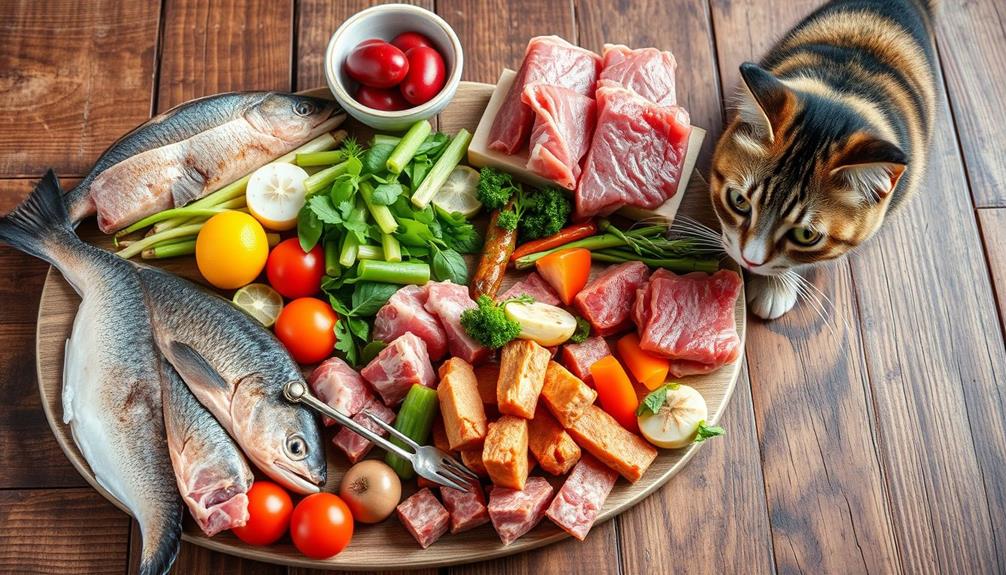
Many cat owners find that switching to a raw food diet can lead to numerous benefits for their feline friends. These diets often enhance your cat's overall health and well-being. Here's a breakdown of some key advantages:
| Benefit | Description | Impact on Your Cat |
|---|---|---|
| Improved Digestion | Higher moisture content aids in digestion and nutrient absorption. | Better nutrient uptake |
| Healthier Skin and Coat | Raw animal products provide essential fatty acids that improve coat quality. | Shiny, vibrant fur |
| Dental Health | Chewing on raw bones reduces plaque and tartar buildup, promoting healthier gums. | Stronger teeth and gums |
Additionally, many cat owners notice increased energy levels in their pets, likely due to a more natural diet. If your cat has food allergies, a limited ingredient raw diet can help manage these issues effectively by allowing you to control specific protein sources. Overall, the benefits to pets from a raw food diet can be significant, leading to happier, healthier cats.
Nutritional Adequacy of Raw Diets
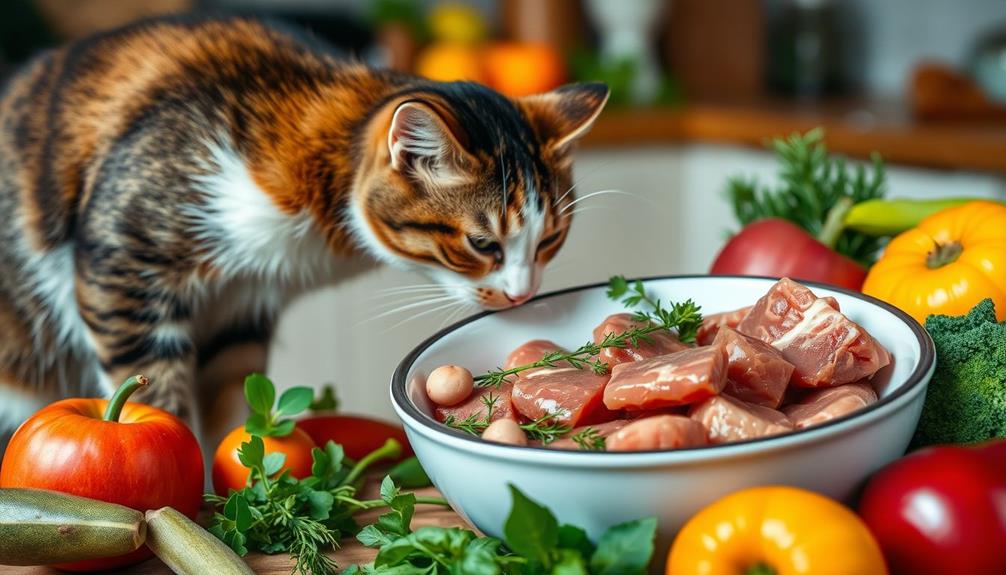
When considering a raw food diet for your cat, you need to be aware of the challenges in achieving a proper nutrient balance.
A well-rounded diet is vital, as deficiencies can lead to serious health issues, similar to the concerns surrounding juice diets and nutrient deficiencies.
It's important to consult with a veterinarian or nutritionist, as they can help formulate a diet that meets all nutritional standards.
Without expert guidance, your cat could face serious deficiencies that jeopardize their health.
Nutrient Balance Challenges
While the appeal of raw food diets (RFDs) for cats is undeniable, guaranteeing they provide a balanced array of vital nutrients poses significant challenges. The nutritional adequacy of RFDs is still debated, with many homemade diets lacking the necessary nutrient balance. This can lead to deficiencies in important vitamins and minerals, such as thiamine, which can adversely affect your cat's nerve, brain, metabolism, and bone health.
Additionally, similar to how diversification strategy is fundamental in investing to reduce risk, a varied diet is imperative for preventing nutrient deficiencies in cats.
While some commercial diets are formulated to meet nutritional standards, the majority of homemade diets fall short. In fact, out of hundreds of analyzed homemade diets, only one was close to meeting the required nutrient profiles set by AAFCO for cat food. This indicates a high risk of nutritional deficiencies that can lead to serious health risks for your feline friend.
To mitigate these risks, it's important to collaborate with a board-certified veterinary nutritionist who can help guarantee that your cat's raw food diet is complete and balanced. Their expertise can make a significant difference in maintaining your cat's health and well-being, so don't overlook this vital step in your raw feeding journey.
Expert Formulation Importance
Ensuring your cat's raw food diet meets all nutritional requirements hinges on expert formulation. Most homemade raw diets often fall short, with only one out of hundreds analyzed coming close to a balanced diet. Many of these diets don't meet AAFCO nutrient profiles, especially those from smaller companies, increasing the risk of nutrient deficiencies.
Collaborating with a board-certified veterinary nutritionist is essential for creating a balanced raw diet tailored to your cat's specific needs. Proper nutrition is vital, as cold medications overview highlights the importance of selecting the right ingredients.
Improperly formulated raw diets can lead to severe health issues, impacting your cat's nerve, brain, metabolism, and bone health. To avoid these risks, consider commercially prepared raw food diets that have undergone expert formulation by veterinary nutritionists.
These diets are designed to meet WSAVA guidelines, ensuring they provide the essential nutrients your cat needs.
Deficiency Risks Assessment
Evaluating the nutritional adequacy of raw food diets (RFDs) for cats is fundamental, as many homemade versions often fall short in providing necessary nutrients.
Incorporating a variety of essential oils for holistic health can support overall well-being, but it's important to guarantee that a cat's primary nutritional needs are met through balanced diets. The risks associated with these diets can lead to significant deficiencies that impact your cat's overall health.
Here are three common deficiencies to watch for:
- Thiamine – A lack of this crucial nutrient can severely affect your cat's nerve and brain health.
- Calcium – Insufficient calcium can compromise bone health and metabolism.
- Taurine – This amino acid is vital for heart and eye health, and deficiencies can be life-threatening.
While there are commercially prepared raw diets available that aim for a complete and balanced diet, caution is still necessary.
Not all commercial raw options are formulated correctly, especially from smaller companies. Without the guidance of a veterinary nutritionist, the risk of nutrient deficiencies escalates, as studies show only one out of hundreds of homemade diets meets AAFCO nutrient profiles.
Regular veterinary consultations are important for monitoring your cat's health and nutritional status, guaranteeing that any deficiencies are addressed promptly.
Safety Concerns With Raw Diets
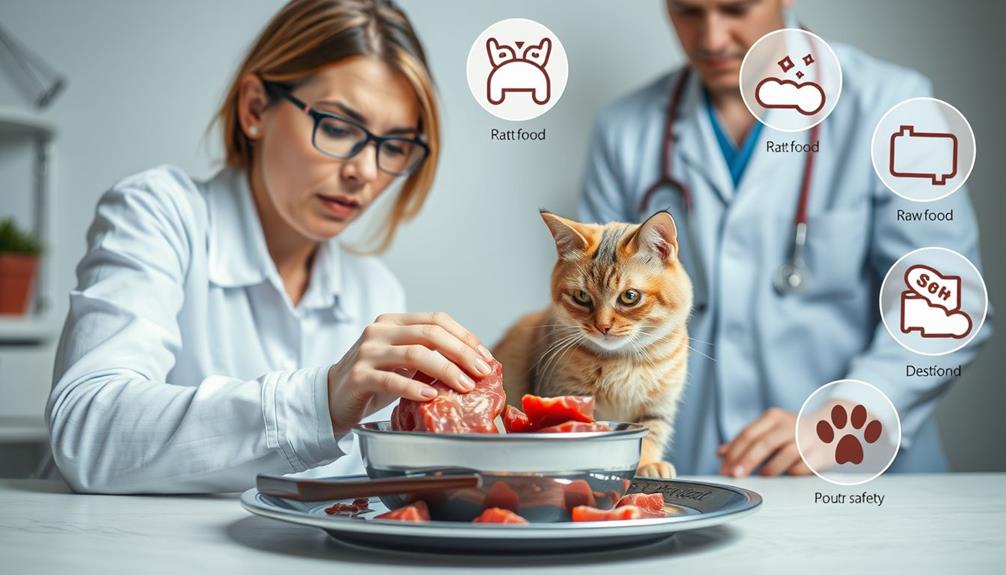
Feeding your cat a raw food diet can come with serious safety concerns that you shouldn't overlook. One major issue is the risk of pathogens like Salmonella and E. coli, which can lead to severe infections in both your pet and yourself. The Centers for Disease Control and Prevention (CDC) and the American Veterinary Medical Association (AVMA) have raised alarms about the potential for zoonotic transmission of these bacteria.
Additionally, understanding financial considerations for elderly care may help pet owners assess the overall impact of their choices on family health and budget.
Improper handling of raw meat can exacerbate these risks, particularly through cross-contamination in your kitchen. If you don't maintain strict sanitation practices, you could expose your entire household to harmful bacteria.
Additionally, raw diets can pose physical dangers for your cat, such as gastrointestinal obstructions or lacerations caused by unground bones, leading to serious health complications.
If you have vulnerable individuals in your home—like young children or those with weakened immune systems—it's vital to be extra cautious. The heightened risks associated with handling raw food mean you may want to reconsider whether this diet is the right choice for your cat.
Prioritize safety to avoid potential health hazards for both your pet and your family.
Expert Recommendations on Raw Feeding
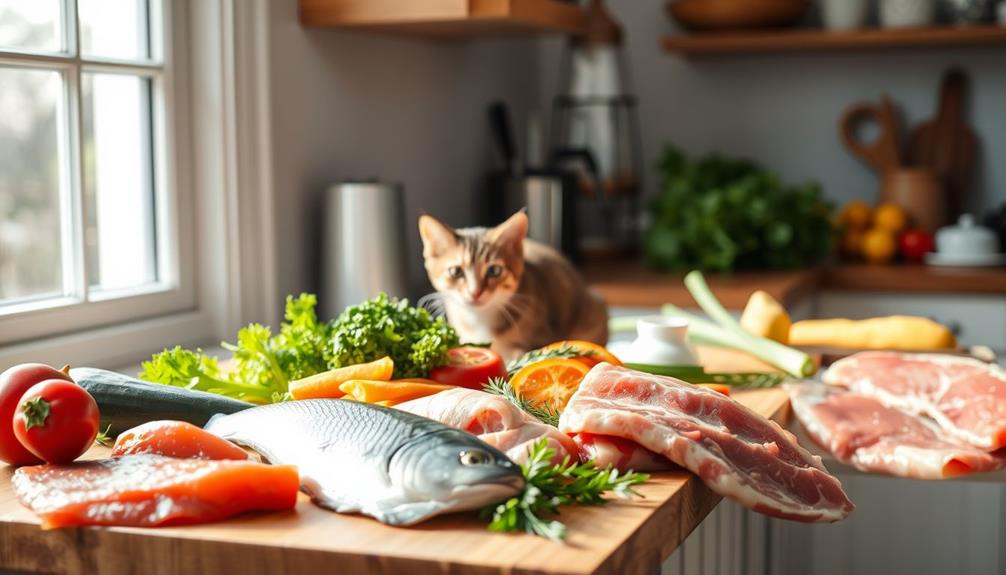
Many pet owners are curious about the viability of a raw food diet for their cats, especially after considering the safety concerns outlined earlier. While raw food diets for cats can provide some benefits such as improved digestion and a shinier coat, they also come with potential risks such as bacterial contamination and nutritional imbalances. It’s important for pet owners to thoroughly research and consult with a veterinarian before deciding to switch their cat to a raw food diet. Additionally, if a raw food diet is chosen, it’s crucial to handle and store the food properly to minimize the risk of foodborne illness for both the cat and the human household members.
Experts, including the American Veterinary Medical Association (AVMA) and the CDC, strongly advise against raw food diets due to significant health risks.
It's important to consult with a financial advisor before making decisions regarding your pet's diet, just as you'd with investments.
Here are some key recommendations:
- Consult a Veterinary Nutritionist: Always seek professional guidance to guarantee any raw diet meets AAFCO standards for complete and balanced nutrition, preventing deficiencies.
- Consider Commercial Options: If you choose to feed raw, opt for commercially prepared diets that comply with WSAVA guidelines and have undergone feeding trials for safety and efficacy.
- Practice Proper Hygiene: Be aware of the rising incidence of Salmonella linked to raw meat-based diets.
Always handle raw food carefully and maintain cleanliness to reduce health risks for both you and your cat.
Types of Raw Diets Available
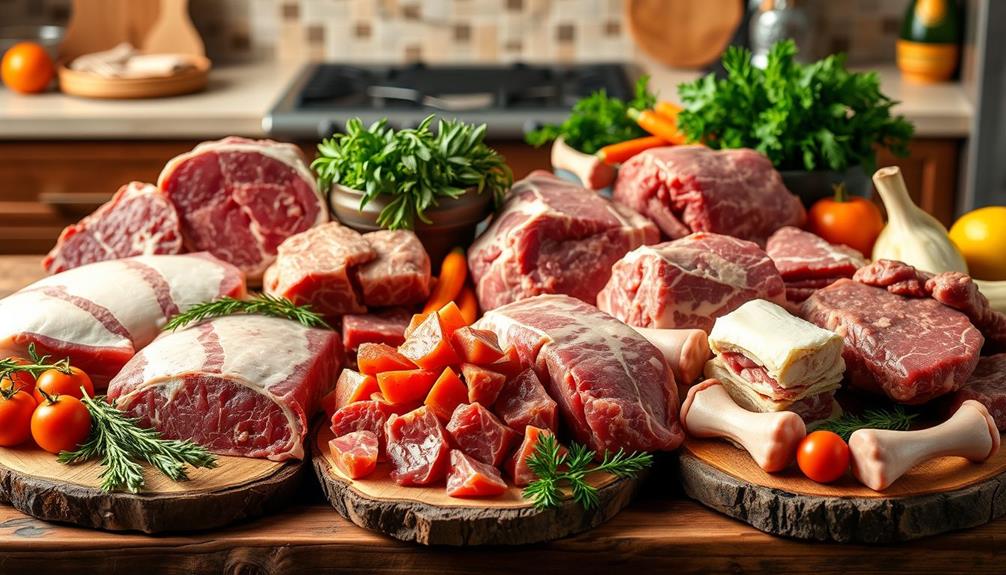
When considering a raw food diet for your cat, you'll find a variety of options available, each with its own benefits and challenges. One popular choice is home-prepared diets, which you can tailor to your cat's preferences. However, these diets often lack nutritional balance unless you consult a veterinary nutritionist.
Adopting a balanced approach is vital for your cat's overall health, similar to the importance of a balanced diet rich in fruits, vegetables, and whole grains for humans.
Another option is commercial frozen raw diets, designed to meet AAFCO standards for nutritional completeness and safety, making them a reliable choice for many pet owners. For convenience, you might consider freeze-dried options or dehydrated raw foods. These types offer longer shelf lives while still retaining essential nutrients found in fresh raw foods.
Each of these raw diets for cats requires careful consideration regarding ingredient sourcing and preparation methods. It's important to verify that the ingredients you choose align with your cat's specific nutritional needs.
Risks of Nutritional Deficiencies
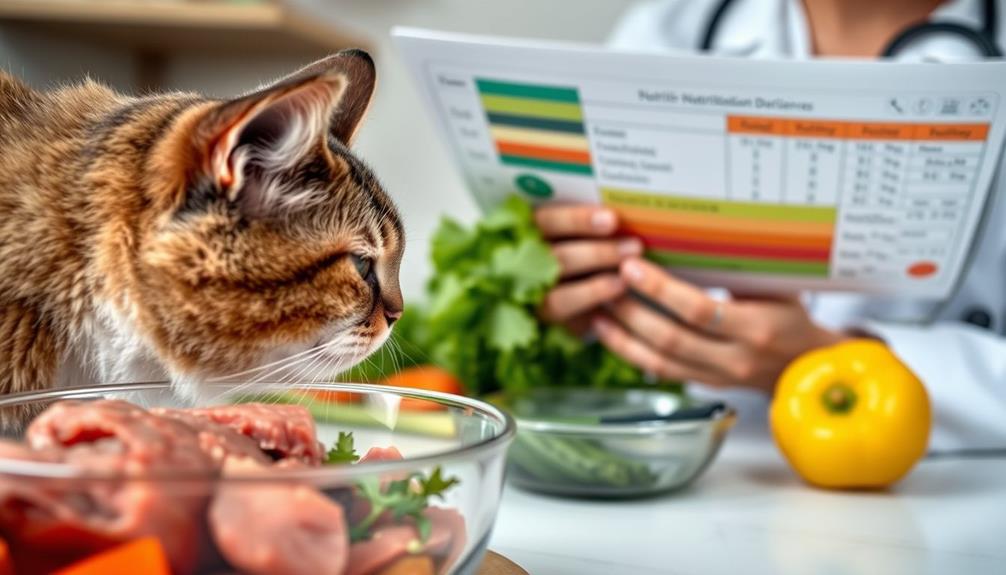
When you switch your cat to a raw food diet, you need to be aware of potential nutritional deficiencies that could arise.
Without proper guidance, your homemade meals might lack essential vitamins and minerals, which are vital for your cat's health.
It's important to guarantee that the diet provides adequate nutrition to avoid health issues, similar to how mammography aims to detect breast cancer early for better treatment outcomes.
Consulting with a veterinary nutritionist can help you create a balanced diet that meets all your cat's needs.
Common Nutritional Deficiencies
A raw food diet for cats can easily lead to significant nutritional deficiencies, posing important risks to their health. Many raw diets lack vital vitamins and minerals, particularly thiamine, which is fundamental for nerve and brain function.
Without proper balance, your cat might face serious health problems, including:
- Neurological disorders – Insufficient thiamine can lead to severe brain and nerve issues.
- Growth problems – Kittens on unbalanced diets may experience stunted growth due to malnutrition.
- Weak immune function – Nutritional deficiencies can result in immune-mediated disease, making your cat more susceptible to infections.
Research shows that homemade raw diets often fail to meet AAFCO nutrient profiles, with only one out of hundreds analyzed close to the necessary standards.
Signs of health deterioration, such as lethargy, weight loss, and gastrointestinal issues, are common in cats fed unbalanced raw foods.
To avoid these risks, it's important to seek expert guidance when planning your cat's diet. Proper formulation is key to ensuring they receive the vitamins and minerals they need to thrive.
Importance of Veterinary Guidance
Steering through the complexities of a raw food diet for your cat can be challenging, and having veterinary guidance is vital. Collaborating with a board-certified veterinary nutritionist is essential when formulating a raw food diet, especially since development influenced by biological factors can impact your cat's nutritional needs.
Many homemade diets are poorly balanced, risking nutritional deficiencies that can lead to serious health issues. For instance, a thiamine deficiency can affect your cat's nerve, brain, metabolism, and bone health if not properly managed.
Critical periods identified for nutrient acquisition highlight the importance of getting it right during formulation.
Studies reveal that only one out of hundreds of analyzed homemade cat diets meets the nutritional requirements set by AAFCO, emphasizing the importance of a balanced diet. Without veterinary guidance, improper formulations can cause gastrointestinal issues and other health complications.
Regular monitoring of your cat's health is necessary to detect early signs of adverse effects from an imbalanced raw diet. Staying in touch with a veterinarian guarantees you're making informed choices based on expert opinions.
Don't take risks with your cat's nutrition; prioritize veterinary oversight to keep your feline friend healthy and thriving on a raw food diet.
Bacterial Contamination and Health Risks
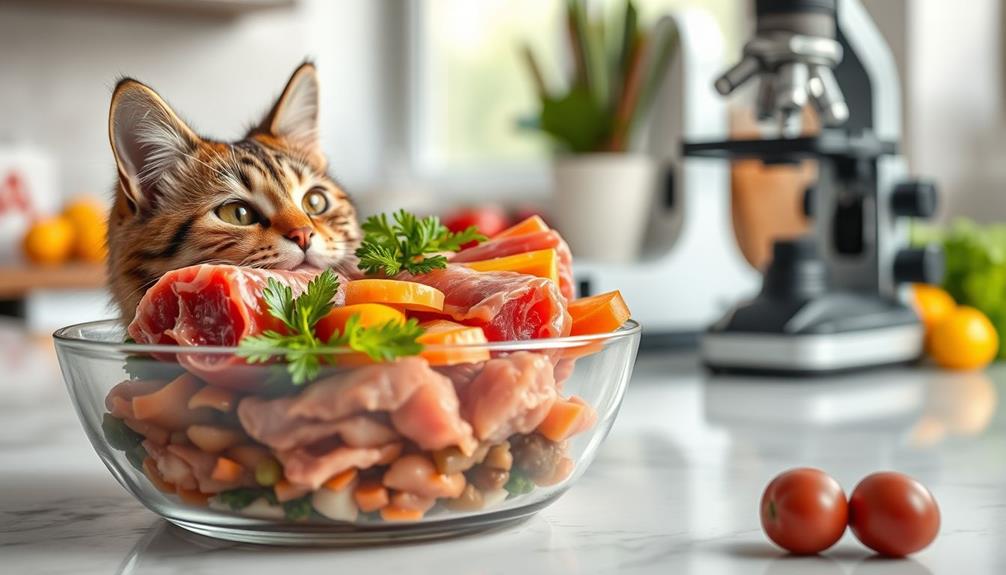
Many raw food diets for cats come with significant health risks due to bacterial contamination. Pathogens like Salmonella and E. coli can thrive in raw meat, posing dangers not just to your feline friend but also to you and your family. The Centers for Disease Control and Prevention (CDC) and the American Veterinary Medical Association (AVMA) caution against these diets due to their potential for serious health issues.
Here are three critical considerations regarding the health risks associated with raw food diets:
- Increased Pathogen Risk: Studies show raw meat contains higher levels of harmful bacteria compared to processed pet foods.
- Zoonotic Infections: Bacteria can easily transfer from pets to humans, especially in households with young children or those with compromised immune systems.
- Public Health Concerns: Pet food manufacturers need to maintain strict hygiene practices to mitigate the risks of bacterial transmission.
If you choose to feed your cat a raw diet, make sure you follow proper handling techniques to reduce the chances of bacterial contamination. Otherwise, you might be putting both your pet and your family at risk.
Veterinary Guidance on Raw Feeding
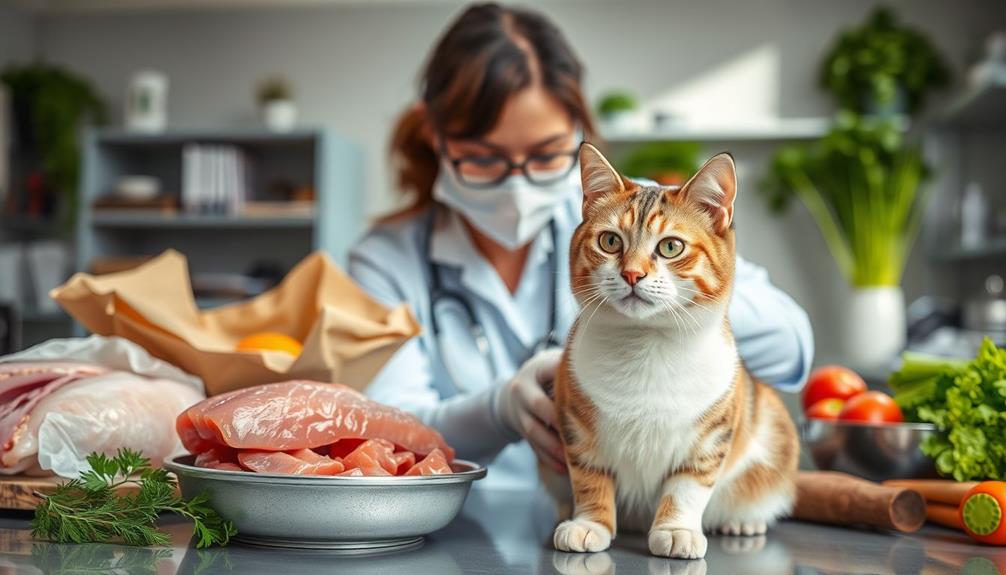
When considering a raw food diet for your cat, it's essential to understand the risks involved, especially regarding nutritional balance and safety.
Consulting with a veterinarian or a board-certified veterinary nutritionist can help you create a diet that meets your cat's needs while minimizing potential health issues.
Regular check-ups will also guarantee that your cat stays healthy and thriving on this feeding regimen.
Risks of Raw Diets
Thinking about a raw food diet for your cat? While the idea may sound appealing, it's important to understand the significant risks associated with raw pet foods. Here are three key concerns to bear in mind:
- Bacterial Contamination: Raw diets can harbor harmful bacteria like Salmonella and Listeria, posing serious health risks not just to your cat but to your household as well.
- Nutritional Deficiencies: Homemade raw diets often lack necessary nutrients, leading to imbalances that can severely impact your cat's health, affecting their metabolism and nerve function.
- Food Handling Risks: Improper food handling practices can increase the risk of cross-contamination. Making sure a sanitized preparation area is critical to minimize infection risks.
Experts, including veterinary organizations such as the FDA and CDC, strongly advise against raw feeding due to these health risks.
Regular veterinary consultations are important if you're thinking about this diet. They can help monitor your cat's health and maintain safe practices.
Ultimately, it's important to prioritize your pet's well-being over dietary trends, guaranteeing they receive a balanced and safe diet.
Nutritional Balance Importance
Feeding your cat a raw food diet requires careful attention to nutritional balance. It's vital to guarantee that the diet is complete and meets all essential nutrient requirements. Imbalanced formulations can lead to serious nutritional deficiencies that affect your cat's health.
While commercially prepared raw food diets may be balanced, homemade raw diets often fall short of meeting AAFCO nutrient profiles.
To create a balanced diet for your cat, collaborating with a board-certified veterinary nutritionist is highly recommended. They can help you formulate homemade raw diets that provide all necessary nutrients, safeguarding against deficiencies like a lack of thiamine, which can severely impact nerve function, metabolism, and overall well-being.
Regular veterinary check-ups are also essential to monitor your cat's health and guarantee their nutritional needs are being met effectively.
Veterinary Consultation Recommendations
Veterinary consultation is vital for pet owners looking to implement a raw food diet for their cats.
Collaborating with a vet helps you navigate the complexities of raw feeding, guaranteeing that your cat's diet is complete and balanced according to their nutritional needs.
Here are three key reasons why you should seek veterinary guidance:
- Nutritional Balance: Many homemade raw diets may lack essential nutrients. Consulting with a board-certified veterinary nutritionist guarantees your cat receives all necessary vitamins and minerals.
- Health Monitoring: Regular vet check-ups are essential for monitoring health and addressing deficiencies or adverse effects that may arise from raw feeding practices.
- Safe Practices: Vets provide education on safely sourcing, preparing, and handling raw pet food, helping you mitigate the risks of feeding, such as bacterial contamination from Salmonella and E. coli.
Alternatives to Raw Food Diets
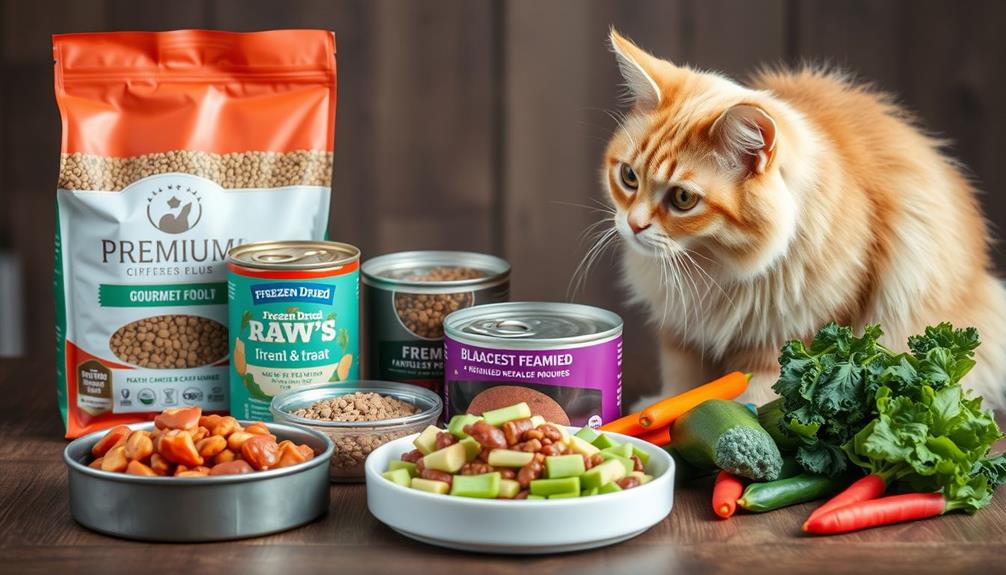
When it comes to keeping your cat healthy, there are several alternatives to raw food diets that can provide balanced nutrition without the associated risks. One option is high-protein wet foods, which not only offer essential moisture but also deliver crucial protein without the dangers of bacterial contamination found in raw diets.
Home-cooked meals can also be a great choice, as you can use safe, cooked ingredients to guarantee your cat gets a balanced diet. Just remember to seek veterinary guidance to formulate these meals correctly.
If you prefer convenience, high-quality dry kibble is available, focusing on low carbohydrate content and high protein to promote ideal health and longevity. Many of these commercial cat foods meet AAFCO standards for complete and balanced nutrition, ensuring your cat receives all necessary vitamins and minerals.
Additionally, specialty diets designed for specific health concerns, such as weight management or food allergies, can provide tailored nutrition without the complications linked to raw feeding practices.
Frequently Asked Questions
Do Vets Recommend a Raw Diet for Cats?
Most vets don't recommend a raw diet for cats due to health risks like bacterial contamination and nutritional imbalances. They suggest you consult a veterinarian for safe and balanced dietary options tailored to your pet's needs.
Is Raw Food Really Better for Cats?
You might wonder if raw food's really better for cats. While some claim benefits, many experts highlight risks like nutritional imbalances and bacterial contamination. It's essential to take into account these factors before making dietary changes for your cat.
Do Cats Live Longer on a Raw Diet?
While some believe a raw diet boosts longevity, evidence is limited. You'll find that balanced nutrition, regular vet visits, and exercise play a more significant role in your cat's overall health and lifespan.
Is There Any Science Behind Raw Diets?
There's some science behind raw diets, but it often highlights risks like bacterial contamination and nutritional deficiencies. You should consider consulting a veterinary nutritionist to guarantee your cat's diet is balanced and safe.
Conclusion
To summarize, while a raw food diet can offer benefits like improved coat health and increased energy, it's crucial to weigh the risks of nutritional deficiencies and bacterial contamination. You should consult your vet, stay informed about proper preparation, and consider alternatives that meet your cat's needs. Ultimately, the best choice for your feline friend balances health, safety, and nutrition, ensuring they thrive, flourish, and live their happiest life.

